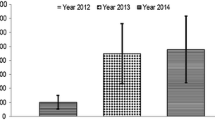Abstract
Pre-transfusion testing includes proper requisitions, compatibility testing and pre-release checks. Proper labelling of samples and blood units and accurate patient details check helps to minimize the risk of errors in transfusion. This study was aimed to identify requisition errors before compatibility testing. The study was conducted in the blood bank of a tertiary care hospital in north India over a period of 3 months. The requisitions were screened at the reception counter and inside the pre-transfusion testing laboratory for errors. This included checking the Central Registration number (C.R. No.) and name of patient on the requisition form and the sample label; appropriateness of sample container and sample label; incomplete requisitions; blood group discrepancy. Out of the 17,148 blood requisitions, 474 (2.76 %) requisition errors were detected before the compatibility testing. There were 192 (1.11 %) requisitions where the C.R. No. on the form and the sample were not tallying and in 70 (0.40 %) requisitions patient’s name on the requisition form and the sample were different. Highest number of requisitions errors were observed in those received from the Emergency and Trauma services (27.38 %) followed by Medical wards (15.82 %) and the lowest number (3.16 %) of requisition errors were observed from Hematology and Oncology wards. C.R. No. error was the most common error observed in our study. Thus a careful check of the blood requisitions at the blood bank reception counter helps in identifying the potential transfusion errors.



Similar content being viewed by others
References
Sazama K (1990) Reports of 355 transfusion-associated deaths: 1976 through 1985. Transfusion 30:583–590
Dzik WH (2006) New technology for transfusion safety. Br J Haematol 136:181–190
Myhre BA, McRuer D (2000) Human error—a significant cause of transfusion mortality. Transfusion 40:879–885
Dzik WS, Beckman N, Selleng K et al (2008) Errors in patient specimen collection: application of statistical process control. Transfusion 48:2143–2151
Porras JRG, Graciani IF, Alvarez M et al (2008) Tubes for pretransfusion testing should be collected by blood bank staff and hand labelled until the implementation of new technology for improved sample labelling. Results of a prospective study. Vox Sang 95:52–56
Lumadue JA, Boyd JS, Ness PM (1997) Adherence to a strict specimen-labeling policy decreases the incidence of erroneous blood grouping of blood bank specimens. Transfusion 37:1169–1172
Sharma RR, Kumar S, Agnihotri SK (2001) Sources of preventable errors related to transfusion. Vox Sang 81:37–41
Varey A, Tinegate H, Robertson J, Watson D, Iqbal A (2013) Factors predisposing to wrong blood in tube incidents: a year’s experience in the North East of England. Transfus Med. doi:10.1111/tme.12050
Lundy D, Laspina S, Kaplan H et al (2007) Seven hundred and fifty-nine (759) chances to learn: a 3-year pilot project to analyse transfusion-related near-miss events in the Republic of Ireland. Vox Sang 92:233–241
British Committee for Standards in Haematology (1996) (BCSH) Guidelines for pre-transfusion compatibility procedures in blood transfusion laboratories. Transfus Med 6:273–283
Murphy MF, Stearn BE, Dziky WH (2004) Current performance of patient sample collection in the UK. Transfus Med 14:113–121
Engelfriet CP, Reessink HW (2004) International forum: transfusion safety in the hospital. Vox Sang 87:48–62
Conflict of interest
None.
Funding
None.
Author information
Authors and Affiliations
Corresponding author
Rights and permissions
About this article
Cite this article
Jain, A., Kumari, S., Marwaha, N. et al. The Role of Comprehensive Check at the Blood Bank Reception on Blood Requisitions in Detecting Potential Transfusion Errors. Indian J Hematol Blood Transfus 31, 269–274 (2015). https://doi.org/10.1007/s12288-014-0444-7
Received:
Accepted:
Published:
Issue Date:
DOI: https://doi.org/10.1007/s12288-014-0444-7



